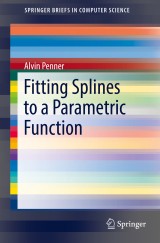Details

Fitting Splines to a Parametric Function
SpringerBriefs in Computer Science
|
53,49 € |
|
| Verlag: | Springer |
| Format: | |
| Veröffentl.: | 23.02.2019 |
| ISBN/EAN: | 9783030125516 |
| Sprache: | englisch |
Dieses eBook enthält ein Wasserzeichen.
Beschreibungen
<div>This Brief investigates the intersections that occur between three different areas of study that normally would not touch each other: ODF, spline theory, and topology.</div><div><br></div><div>The Least Squares Orthogonal Distance Fitting (ODF) method has become the standard technique used to develop mathematical models of the physical shapes of objects, due to the fact that it produces a fitted result that is invariant with respect to the size and orientation of the object. It is normally used to produce a single optimum fit to a specific object; this work focuses instead on the issue of whether the fit responds continuously as the shape of the object changes. The theory of splines develops user-friendly ways of manipulating six different splines to fit the shape of a simple family of epiTrochoid curves: two types of Bézier curve, two uniform B-splines, and two Beta-splines. This work will focus on issues that arise when mathematically optimizing the fit. There are typically multiple solutions to the ODF method, and the number of solutions can often change as the object changes shape, so two topological questions immediately arise: are there rules that can be applied concerning the relative number of local minima and saddle points, and are there different mechanisms available by which solutions can either merge and disappear, or cross over each other and interchange roles. The author proposes some simple rules which can be used to determine if a given set of solutions is internally consistent in the sense that it has the appropriate number of each type of solution.</div>
1 Introduction.- 2 Least Squares Orthogonal Distance.- 3 General Properties of Splines.- 4 ODF using a cubic Bézier.- 5 Topology of Merges/Crossovers.- 6 ODF using a 5-Point B-spline.- 7 ODF using a 6-Point B-spline.- 8 ODF using a quartic Bézier.- 9 ODF using a Beta2-spline.- 10 ODF using a Beta1-spline.- 11 Conclusions.
Investigates if the fitted spline shapes respond smoothly to changes in the shape of the curve being fit, for example when discussing the animation of shapes Presents a general derivation of the ODF method, customized for fitting a continuous parametric function. This contains some results which may be new, or at least expressed in unfamiliar form Summarizes some previously derived properties of splines, including only those results that are absolutely essential for the description of a uniform B-spline Outlines the results of the ODF curve fit using two types of Bézier curve, a description of two types of uniform B-spline fits, and Beta-spline curve fits. The process of how solutions coalesce and/or cross each other are are discussed in the context of the cubic Bézier curve fit
Diese Produkte könnten Sie auch interessieren:

Mixed-Signal Layout Generation Concepts

von: Chieh Lin, Arthur H.M. van Roermund, Domine Leenaerts

96,29 €

System-Level Design Techniques for Energy-Efficient Embedded Systems

von: Marcus T. Schmitz, Bashir M. Al-Hashimi, Petru Eles

96,29 €














